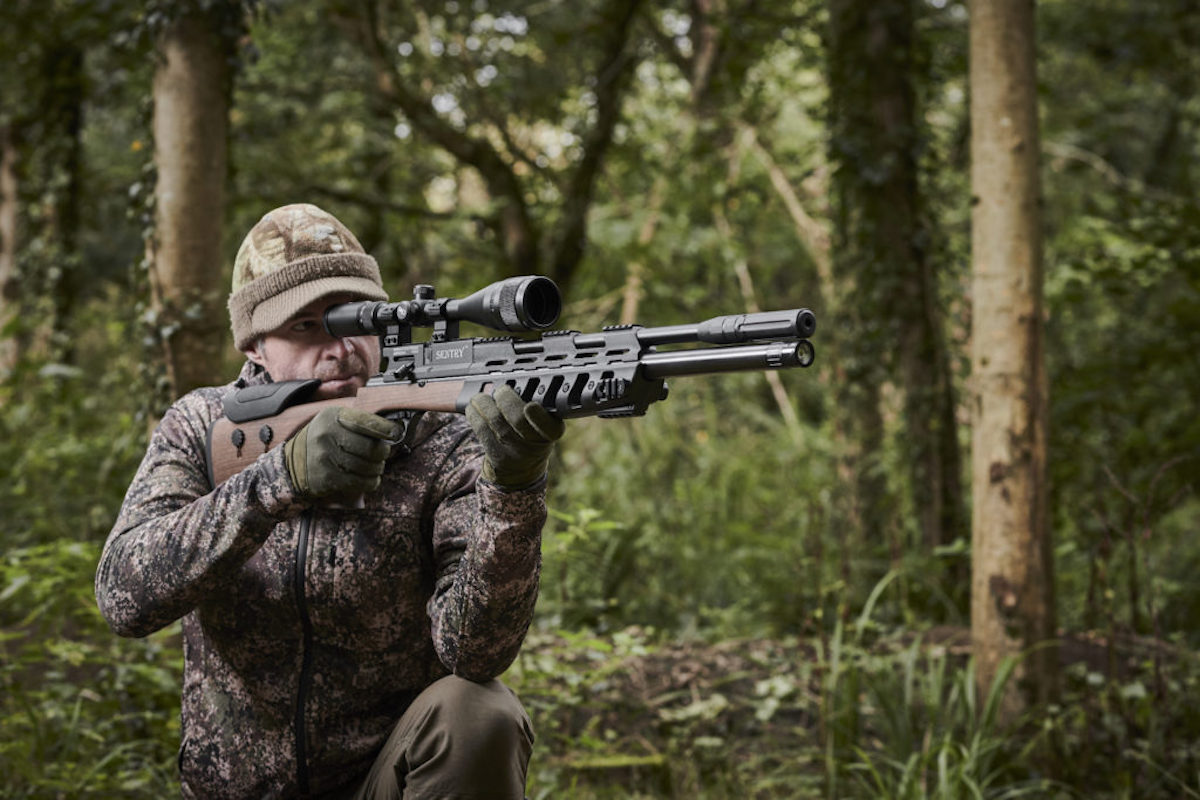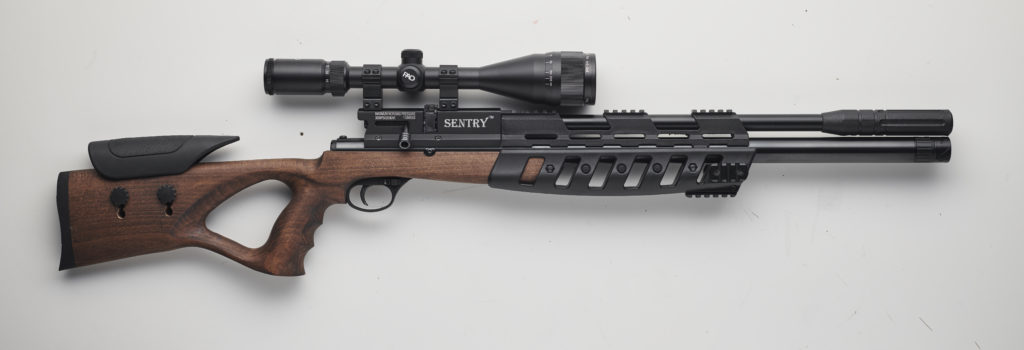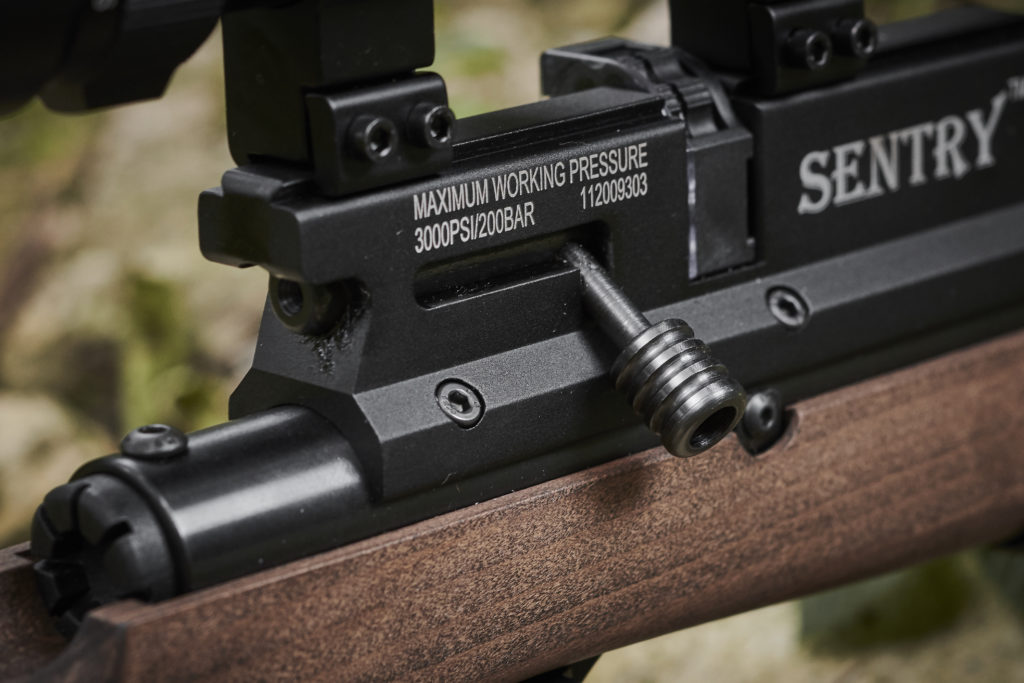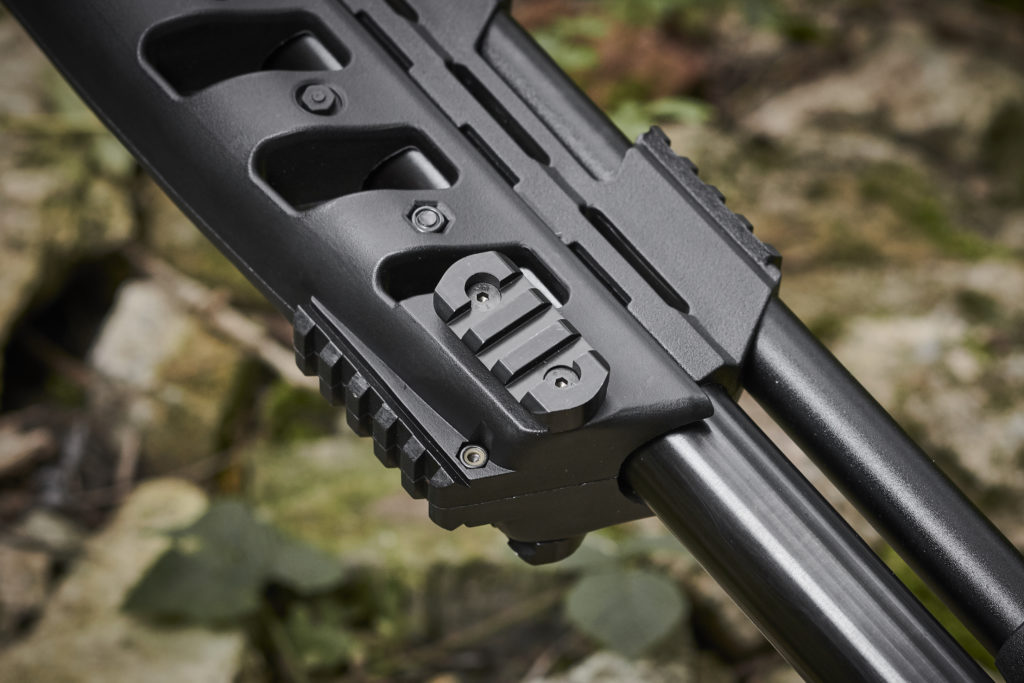Lee Enfield Sentry
Mat Manning gives his verdict on the Lee Enfield Sentry, an affordable PCP that bridges the gap between sporter and tactical styling.

The distinctively styled multi- shot Lee Enfield Sentry boasts some impressive features and retails for just £399 making it a very appealing passport to recoil-free airgunning for shooters on a tight budget. (Read more on affordable air rifles here.)
First impressions of the Lee Enfield Sentry
The Sentry certainly has its own look.
Measuring 103cm and with a 36cm length of pull, it is an airgun for adult- sized shooters. Despite looking pretty chunky, it tips the scales at a very manageable 3.7kg before you fit a scope. With optics mounted, the point of balance falls about 10cm in front of the trigger. That feels about right once you have it shouldered and the Sentry is a nice gun to shoot from a variety of stances.
The stock is certainly distinctive and the main part for the long forend is made from ballistic polymer. Large cutaway vents help to shave down weight and make for an extremely secure hold. The forend is also equipped with numerous accessory rails – there’s one on each side, one on the underside and no less than three above the barrel.
Shooters who like to adorn their airguns with add-ons like lamps, lasers and bipods will not be disappointed. (Read more on the best airgun accessories.)
Offsetting the tactical forend is a nicely grained piece of hardwood that makes up the rear section of the ambidextrous stock. It has been sculpted into rather an elegant thumbhole design with a steep, chunky pistol grip which really fills the hand.
Another nice touch is the adjustable cheekpiece; made from ballistic polymer it can be adjusted up and down by simply slackening off its two retaining screws – no tools are required.
Lee Enfield Sentry: specification

MAKER: Lee Enfield (Guns) Ltd SUPPLIED BY: The Shooting Party MODEL: Sentry PRICE: £399 TYPE: Bolt-action PCP CALIBRE: .177 (tested) and .22. OVERALL LENGTH: 1030mm LENGTH OF PULL: 360mm WEIGHT: 3.7kg (without scope) POWER: 11.4 ft-lb
Features and function
Scope rails are of the dovetail type. I paired the Sentry with quite a large PAO scope and there was more than enough clamping space to mount it properly. Overall engineering of the gun looks pretty tidy, and I particularly like the black anodised finish of the barrel shroud.
The shroud is finished with a silencer which really suits the Sentry’s styling. It isn’t the quietest moderator I have ever used (the one on the review gun didn’t appear to be removable and I was unable to dismantle it to see what baffles it uses), but it does provide a reasonable degree of sound suppression.
You have to manage your expectations when it comes to the trigger on a sub-£400 PCP, but it has to be said that the Sentry’s is actually pretty good. I can’t fault the blade design, which comprises a fairly standard curved profile with a flat face.
The first stage feels good and comes to a clear stop, but there is some creep in the second stage, which is quite typical at this price point. Nonetheless, the weight and travel of the second stage are spot on, and its break point is consistent and very easy to predict after taking just a few shots.
Safety is always an important consideration and there is a discreet manual safety catch positioned at the top of the polymer trigger guard. It is easy to access and just about far enough from the trigger blade for my liking. It’s safe when it’s in the forward position and you nudge it back when you want to shoot. Hunters will be pleased to know that it is very quiet to operate.

The sturdily constructed cocking bolt is very strong and provides the shooter with plenty of grip
The Sentry comes supplied with two magazines and a single-shot tray. The magazine holds nine shots in .177 calibre and eight in .22, and is very easy to reload. Pull back the bolt and it pulls out from the left-hand side ready for you to drop a pellet into the first chamber.
You then turn the inner cassette anti-clockwise against the spring tension to reveal each of the remaining chambers until it’s fully loaded. The magazine even features a clear backplate so you can see how many pellets you have in there.
Cocking and loading is driven by a side bolt action which has a sturdy and very grippy handle. The rear stroke cocks the gun and indexes the magazine, and the forward stroke probes home the pellet. (Read our guide to the best air rifle pellets.)
You have to be positive with the bolt to ensure that the backward stroke clicks all the way back, but it doesn’t feel at all rough, and is still pretty quick and very reliable – it cycled flawlessly every time during my testing.
From a full 200 bar fill the Sentry returns more than 80 shots in .177 calibre and about 120 in .22. As for muzzle energy, the .177 test gun churned out a pretty consistent 11.4 ft-lb. Air level is displayed on the gauge at the front of the cylinder – I don’t like having to peer down from the muzzle end to check air pressure, but this configuration now seems to be fairly standard.
One very interesting touch with the gauge is that it glows in the dark, so you don’t need a torch to read it at night. Positioned just behind the gauge is a collar which keeps the inlet free from dirt and dust.
Twist the collar and the port is exposed, ready for you to plug in the supplied quick-fill probe. Rather than being screw-fit, the probe attaches via a Foster connector, which I really like as it makes for quick and easy swapping between probes if you use the same bottle to refill several different airguns.
On the range
A price tag of less than £400 is competitive for a decent spring gun these days, and therefore amounts to an absolute steal for a PCP. Of course, the savings have to be made somewhere and you can’t expect to go out and win competitions with a pre-charged airgun at the Sentry’s price point.
Despite my reservations, the Sentry did manage to give an impressive account of itself at 20m, producing ragged one-hole groups more or less every time. Pushing the range out to 30m made things more challenging, with almost every five-shot group let down by a single flier which strayed wide of the mark.

Nonetheless, even with these rogue shots, groups were generally remaining within 25mm from centre to centre – without them it would have been more like 15mm. I did initially think that it might have been down to the magazine, but it was the same with the single shot tray fitted. It could well have been a quirk with the review gun or maybe I just didn’t find the right pellet match – my best results were with QYS Streamline Heavy ammo.
Even with those occasional odd stray shots, the Sentry was consistent enough to be able to tackle live quarry out to mid-range and I thoroughly enjoyed shooting it.
The bolt-action, magazine-fed cocking and loading system is very reliable and the trigger delivers good, predictable shot release. You certainly get a lot of gun for your money, and of course, if you want to spend a bit more you can opt for the bipod and tactical case too.
It may be affordable, but the Lee Enfield Sentry feels to be extremely solidly constructed and whether you want it for plinking or pest control I would expect it to give very good service.
The Airgun Shooter verdict
Look & Feel – 8 Stock – 8 Build quality – 8 Sighting up – 8 Cocking – 9 Trigger – 7 Handling – 8 Accuracy – 7 Value – 9
Overall score: 80
Verdict
A very appealing passport to recoil-free airgunning for shooters on a tight budget.








